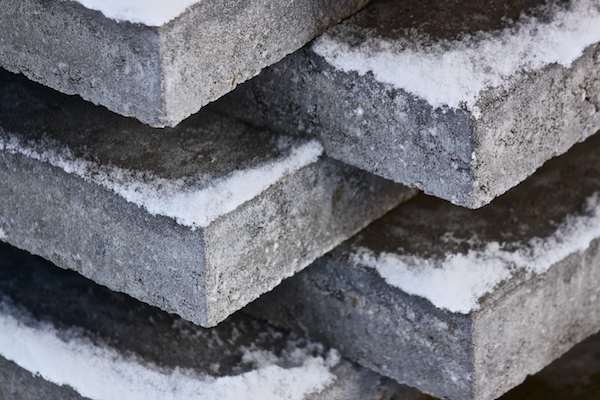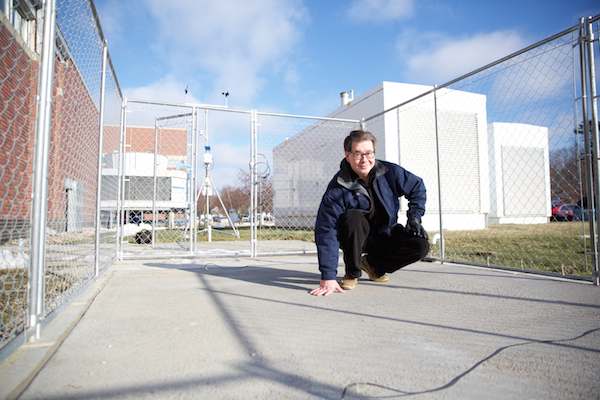
[Image above] Credit: DeathBy8bits; Flickr CC BY-NC 2.0
A pinch of steel shavings and a dash of carbon particles may soon make the recipe for success when it comes to winter roadway travel.
Researchers at the University of Nebraska-Lincoln have developed a winning recipe for electrically conductive concrete that can gently heat up to melt away icy accumulations, yet remain safe to the touch.
The team, led by civil engineering professor Chris Tuan, says that swapping out just 20% of the standard concrete formulation with a bit of steel fibers and shavings and carbon particles is enough to conduct electricity throughout the ubiquitous building material.
Connecting the conductive concrete to a low power source gives it the heat to melt away snow and ice. “There are two steel rods running lengthwise along the pavement,” Tuan says in an email. “Various power sources, AC or DC, may be applied. We have used three-phase, 208V AC with success. You turn the power on a few hours before the storm, and turn it off when not needed.”
The team is currently testing a 200-square-foot slab of its conductive concrete at the university’s campus for the Federal Aviation Administration, which may incorporate the material into future airport tarmacs. The testing runs through March 2016, according to a University of Nebraska press release.

Chris Tuan stands on the test slab of conductive concrete at the University of Nebraska-Lincoln. Credit: Scott Schrage/University Communications

A slab of conductive concrete demonstrates its de-icing capability outside the Peter Kiewit Institute in Omaha during a winter storm in December 2015. Credit: Chris Tuan and Lim Nguyen; University of Nebraska-Lincoln
“To my surprise, they don’t want to use it for the runways,” Tuan says in the release. “What they need is the tarmac around the gated areas cleared, because they have so many carts to unload—luggage service, food service, trash service, fuel service—that all need to get into those areas.”
Clearing the way for service carts to access planes, especially during inclement weather, could greatly reduce travel delays in cold climates.
Hear more about the technology from Tuan himself—and see the concrete melt away 4 inches of winter snow—in the news segment below.
Credit: WOWT 6 News; YouTube
And there’s rather good reason to think the concrete test will be a success.
Tuan and his team previously completed a five-year trial of conductive concrete on the Roca Spur Bridge just south of Lincoln, in Roca, Neb. The heated bridge deck, installed in 2002, contains 52 conductive concrete slabs that have proved how effective the material solution could be in targeted places, such as on bridges.
“Bridges always freeze up first, because they’re exposed to the elements on top and bottom,” Tuan says in the release. “It’s not cost-effective to build entire roadways using conductive concrete, but you can use it at certain locations where you always get ice or have potholes.”
The conductive concrete bridge deck proved its worth, according to the project’s final report to the Nebraska Department of Roads.
This experimental bridge deck, after five years of evaluation, has shown that using conductive concrete has the potential to become a very cost-effective bridge deck deicing method. The technology provides an environment-friendly solution to address the looming crisis of water supply contamination by road salts, particularly on bridge decks over streams and rivers in the cold regions.
The report estimates an energy cost of just $250 to heat the bridge during a typical Nebraska winter storm—several times less than the cost of a truckload of de-icing chemicals.
In addition to its clear benefits for travel and cost, heated concrete could benefit the environment and city workers, too. According to the release, “Potholes often originate from the liberal use of salt or de-icing chemicals that can corrode concrete and contaminate groundwater over time, Tuan said, making the conductive concrete an appealing alternative with lower operating and maintenance costs.”
Many teams have tried versions of conductive concrete in the past—including one iteration that was powered by solar energy—but all those attempts have failed in implementation because of high operating costs.
According to a National Geographic article, the new concrete developed by Tuan and his team “uses byproducts from the coal and steel industries to reduce costs 60% compared to earlier trials.”
But just because the team’s concrete is so promising for winter conditions doesn’t mean the researchers take a break in the absence of icy weather. Instead, they have found additional uses for some of their other unique concrete formulations.
One of the most promising of those developments—which Tuan patented through the University of Nebraska-Lincoln’s commercialization center, NUtech Ventures—is like a concrete Faraday cage.
The concrete, which requires no electrical current, can block electromagnetic waves because it contains aggregates rich in magnetite in addition to steel and carbon particles.
Tuan says the concrete could protect against espionage because of its ability to shun radiofrequency waves, which the researchers demonstrate in a structure they’ve built in the lab.
“We invite parties that are interested in the technology to go in there and try to use their cellphones,” Tuan says in the release. “And they always receive a no-service message.”
